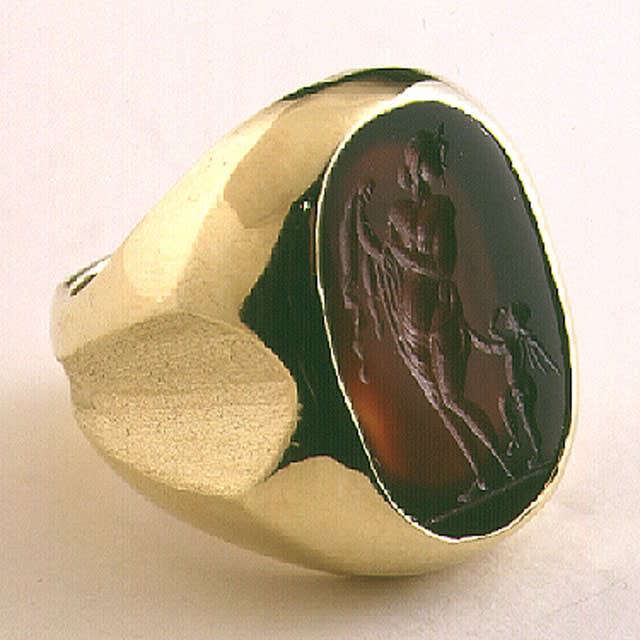Gold Ring Featuring a Classical Revival Intaglio of Aphrodite and Eros, 1700 CE - 1800 CE
Carnelian and Gold
FJ.6381
This genuine antique Classical Revival carnelian intaglio seal has been mounted in a modern 18 karat gold ring. The art of glyptics, or carving on colored precious stones, is probably...
This genuine antique Classical Revival carnelian intaglio seal has been mounted in a modern 18 karat gold ring.
The art of glyptics, or carving on colored precious stones, is probably one of the oldest known to humanity. Intaglios, gems with an incised design, were made as early as the fourth and third millennia BC in Mesopotamia and the Aegean Islands. They display a virtuosity of execution that suggests an old and stable tradition rooted in the earliest centuries. The tools required for carving gems were simple: a wheel with a belt-drive and a set of drills. Abrasives were necessary since the minerals used were too hard for a "metal edge. A special difficulty of engraving intaglios, aside from their miniature size, was that the master had to work with a mirror-image in mind.
Aphrodite, (Roman Venus), goddess of love, and her impish son Eros (Cupid) are among the most popular themes in ancient and Renaissance art. In mythology Eros, the little winged god, was forever troubling the hearts of men with arrows of love; sometimes hitting the mark, and more often causing comic confusion. Here we see Aphrodite scantily clad in a light wrap stepping aside from Eros, who seems to be particularly prankish. A sense of whimsy and fun is wonderfully captured on this finely engraved intaglio, bringing to life myths the Western world has enjoyed for centuries.
The art of glyptics, or carving on colored precious stones, is probably one of the oldest known to humanity. Intaglios, gems with an incised design, were made as early as the fourth and third millennia BC in Mesopotamia and the Aegean Islands. They display a virtuosity of execution that suggests an old and stable tradition rooted in the earliest centuries. The tools required for carving gems were simple: a wheel with a belt-drive and a set of drills. Abrasives were necessary since the minerals used were too hard for a "metal edge. A special difficulty of engraving intaglios, aside from their miniature size, was that the master had to work with a mirror-image in mind.
Aphrodite, (Roman Venus), goddess of love, and her impish son Eros (Cupid) are among the most popular themes in ancient and Renaissance art. In mythology Eros, the little winged god, was forever troubling the hearts of men with arrows of love; sometimes hitting the mark, and more often causing comic confusion. Here we see Aphrodite scantily clad in a light wrap stepping aside from Eros, who seems to be particularly prankish. A sense of whimsy and fun is wonderfully captured on this finely engraved intaglio, bringing to life myths the Western world has enjoyed for centuries.
